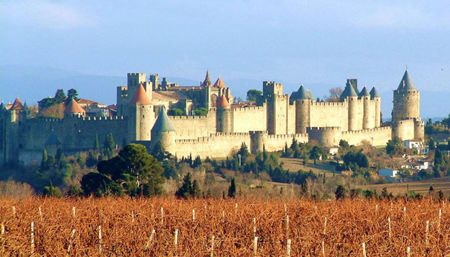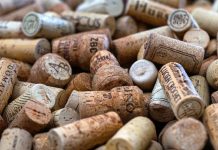My first glimpse of the medieval French town of Carcassonne was on a grey and dismal December day when I was driving, rather aimlessly I admit, from Northern Spain towards the French town of Narbonne. At the time, you could put your car on a freight train in Narbonne and then take another train to Paris where magically, you’d meet your car the next morning, thus saving a lengthy drive through France.
Even in the bleak mid-winter, the fortress of Carcassonne is an impressive sight with its castle-like double walls, majestic turrets and its jumble of stone buildings. This ancient town sits among a vast ocean of vines, for it lies near the middle of the Languedoc wine-growing region. It’s the single biggest wine-producing region in the world. But in December, nothing much happens in the vineyards. Nothing much at all, because the vines are virtually hibernating.
 Carcassonne: The town among the vines.
Carcassonne: The town among the vines.
I mention all this because Carcassonne is the home to the wine company LGI, founded in 1999 by the French wine producer Alain Grignon. The company has dedicated itself to the export market and has developed expertise in sourcing wines from both Gascony and the Languedoc. It produces some very exciting wines too, including the Rare Vineyards collection that brings together unconventional wines from familiar regions.
Rare Vineyards Sauvignon Blanc 2012 (white), Côtes de Gascogne, France (Bt. 599 @ Wine Connection)
You’ve heard about Sauvignon Blanc often enough. But the Côtes de Gascogne? Well, it’s a wine-growing district in the old French region of Gascony which lies on the Atlantic side of France and stretches from Bordeaux down to the Spanish frontier and the Pyrenees. Strangely enough, although most of its neighbours produce red wines, the Côtes de Gascogne produces mostly whites – around 91% to be exact. These are made from a variety of grapes, notably Colombard, Sauvignon Blanc, Sémillon and Muscadelle. They also grow a few oddly-named local varieties such as Petit Manseng and Gros Mansen along with Ugni Blanc, probably better known by its Italian name, Trebbiano.
This Sauvignon Blanc (SOH-vihn-yohn BLAHN) is a very pale straw colour with an extraordinary rich, fruity aroma of pear, peach and melon. There’s a delicate hint of boiled sweets and a touch of grassiness too. But the aroma alone is worth the money. If you sniff the wine a hundred times it’s less than six baht a go, though few people I imagine would want to spend that amount of time lingering over the aroma. Except possibly me. Now I come to think about it, there’s also a faint mineral character in the aroma which is not altogether surprising, because this is fairly typical of a Sauvignon Blanc.
The taste comes as quite a surprise. It’s much fuller and richer than I expected, with loads of citrusy fruit on the palate and a lovely dry tang of acidity. The taste fairly fills the mouth and there’s an exceptionally long, clean and lemony dry finish. This would make a terrific apéritif because the sprightly touch of grapefruit-like acidity would kick the taste buds into anticipation. This wine has plenty of Sauvignon Blanc character but much more intense than most Sauvignons I have come across recently. I think it would make a great partner for your roast chicken or a rich and fully-flavoured cheese quiche.
Rare Vineyards Grenache 2012 (red), Pays d’Oc, France (Bt. 599 @ Wine Connection)
The aroma of this wine will probably hit your snout the moment you open the elegantly tapered bottle. It’s rather spicy and peppery with hints of bramble, olive and dark fruit. But honestly, if you want to smell this wine at full volume, you’ll need to let the air get to it. Ideally, tip it into a wine jug or decanter and leave it to rest for about ten minutes. After that time, you might pick up the vaguely peppery, earthy aromas that are typical of wines made from this grape. Grenache (gruh-NAHSH) incidentally is one of the most widely-planted red wine grape varieties in the world and it’s especially popular in France and Spain. This black-skinned grape likes hot, dry conditions and it’s the dominant variety in most of the wines from the Southern Rhône, especially those from the Châteauneuf-du-Pape region. The words Pays d’Oc on the label mean that it’s a country wine made from grapes grown in Languedoc-Roussillon.
The grapes that made this wine were grown on old vines and as you probably know already, the older the vines, the better the grapes. Oh, and before I forget, the wine was awarded a Gold Medal at a recent Berlin Wine Trophy competition, one of the most important international wine tastings in Germany and one of the largest and most recognised tastings world-wide.
Being a dog in a previous life, I tend to spend quite a lot of time over the aroma of a wine, unlike some of my friends who can’t resist tasting it after only a couple of feeble sniffs. The other night I was having dinner with someone who took a hearty swig of the newly-served wine without even bothering to enjoy the aroma, or for that matter, even sniffing it to make sure that the wine was drinkable. But really it was such a waste, because in my view he was missing at least sixty percent of the enjoyment.
This is a wine with firm structure and richness, beautifully balanced with plenty of black fruit on the palate. It’s smooth and very dry with a tiny dash of acidity. There’s a very long, satisfying finish and typical of Grenache, it’s also very low in tannin. This wine is exceptional and Wine Connection has certainly scored a few Brownie Points for bringing it here. It seems to me rather a food wine and I am sure it would be perfect with most red meat dishes, game, casseroles, or rich cheeses. It will probably be at its best slightly on the cool side.
Normally, Grenache is used as a blending grape and a wine made of 100% Grenache is rather unusual. But talking of grapes, a report due out this week from a leading British wine magazine reveals the staggering fact that 30% of British wine consumers cannot name a single grape variety. And just in case you’re wondering, according to a book published in 2012 by wine experts Jancis Robinson and Julia Harding, there are about 10,000 grape varieties and 1,368 of these produce wine in commercial quantities. My guess is that most of the wine in the world is made from about 80 varieties, but how many of them can you name? Sauvignon Blanc and Grenache are two for starters.




